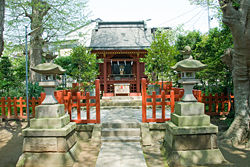- Moto Hachiman
-
Yui Wakamiya
由比若宮
The honden Information Type Hachiman shrine Dedicated to Hachiman Founded 1063 Founder(s) Minamoto no Yoriyoshi Address Zaimokuza 1-7-9 Phone None Website None Moto Hachiman (元八幡) is a small but very old and historically important Shinto shrine in Kamakura, Kanagawa Pref., Japan.
Contents
History
Although officially called Yui Wakamiya (由比若宮), this tiny shrine in Zaimokuza is universally known as Moto Hachiman ("original Hachiman", a nickname which appears even on road signs), and in front of its torii stands a stele with the words Moto Tsurugaoka Hachiman-gū (元鶴岡八幡宮)[1]. This unattended shrine consists of just a torii, two stone lanterns (tōrō), and a honden or sanctuary, where the kami Hachiman is enshrined. It is however illustrious because it is the original location of the great Tsurugaoka Hachiman-gū, symbol of Kamakura.
The sign that stands in front of the shrine says:[2]:
About the origin of the name Tsurugaoka Hachiman-gū, the Azuma Kagami says that: "Minamoto no Yoriyoshi, after his victorious campaign against Abe no Sadatō, in August 1063 erected this temple and transferred in it part of Kyoto's Iwashimizu Hachiman-gū's kami[3]. In February 1081 the shrine was repaired by Minamoto no Yoshiie."
It is likely that this area was then called "Tsurugaoka". On the 12th day of the 10th month of 1180[4] Minamoto no Yoritomo, in order to worship his ancestors, had Yui Wakamiya transferred from its current spot to the mountain north of an area called Kobayashi, and that became Tsurugaoka Hachiman-gū. When the Azuma Kagami says that Minamoto no Yoritomo at last visited his distant ancestors at Tsurugaoka Hachiman-gū, it means this shrine. The new shrine used its predecessor's name without changes. From that moment, this place has been called Moto Hachiman.Yoriyoshi's decision had profound consequences for the country, because, since Hachiman was the Minamoto's tutelary kami, Kamakura was now the land of his family's ancestors [5]. This, together with the fact Kamakura is a natural fortress and his desire to leave Kyoto, convinced Yoritomo this was the right place to found his shogunate[5]. As a consequence, Kamakura became the unofficial capital of Japan.
It is unclear when the shrine's official name was changed into Yui Wakamiya. Moto Hachiman is National Historic Site[6].
Notes
- ^ The first part of its official name derives from the nearby beach of Yuigahama. For details, see the article Yuigahama
- ^ Original Japanese text available here
- ^ A kami is transferred from a shrine to another through a process of subdivision and transfer called kanjō (勧請). The shrine which receives the kami is usually considered of a lower status
- ^ Lunar date
- ^ a b Kusumoto (2002:18-19)
- ^ Kamiya (2008:180)
References
- Kamiya, Michinori (2008) (in Japanese). Fukaku Aruku - Kamakura Shiseki Sansaku Vol. 1 & 2. Kamakura: Kamakura Shunshūsha. ISBN 4774003409. OCLC 169992721.
- (Japanese) Kusumoto, Katsuji (July 2002) (in Japanese). Kamakura Naruhodo Jiten. Tokyo: Jitsugyō no Nihonsha. ISBN 978-4-408-00779-3.
- (Japanese) Kamakura Shōkō Kaigijo (2008) (in Japanese). Kamakura Kankō Bunka Kentei Kōshiki Tekisutobukku. Kamakura: Kamakura Shunshūsha. ISBN 978-4-7740-0386-3.
External links
- Area:Zaimokuza by the Kamakura Citizen's Net, retrieved on June 22, 2008.
Coordinates: 35°18′46″N 139°33′10″E / 35.312726°N 139.552647°E
Shinto shrine Shinto architecture Buildings - chōzuya or temizuya
- haiden
- heiden
- hokora
- honden / shinden / shōden
- kagura-den
- massha
- sessha
Architectonic elements Styles - hirairi-zukuri
- tsumairi-zukuri
- gongen-zukuri
- hachiman-zukuri
- hiyoshi-zukuri
- irimoya-zukuri
- ishi-no-ma-zukuri
- kasuga-zukuri
- kibitsu-zukuri
- misedana-zukuri
- nagare-zukuri
- ōtori-zukuri
- owari-zukuri
- ryōnagare-zukuri
- shinmei-zukuri
- sumiyoshi-zukuri
- taisha-zukuri
Others Implements Main kami Staff Head shrines1 - Fushimi Inari Taisha
- Usa Hachiman-gū
- Ise Grand Shrine
- Dazaifu Tenman-gū
- Munakata Taisha
- Suwa Taisha
- Hiyoshi Taisha
- Kumano Nachi Taisha
- Tsushima Shrine
- Yasaka Shrine
Miscellaneous 1 (in order of the size of the shrine network they head)
Categories:- Kamakura, Kanagawa
- Shinto shrines in Kanagawa Prefecture
Wikimedia Foundation. 2010.
